The story of prominent Eskandaris has been told and retold in many publications, as they earned themselves a place of note on the Persian/Iranian political and intellectual scene. The Eskandaris are a prominent family among the Qajar (Kadjar) princes, whose names are ineluctably linked with the political events of 20th century Persia/Iran, starting with the constitutional movement of 1906 and ending with the post-revolutionary events of 1980. Before 1906, the Eskandaris distinguished themselves as writers and intellectuals who were among the first in Persia to introduce the court, the nobility, and the intelligentsia of the time to the French language. This tradition of intellectual rigor and love of learning has remained in the family throughout.
Politically, the Eskandaris have always been aware of their heritage as Qajar (Kadjar) princes as well as of their intellectual and moral duty. The princes listed below, have all in some way followed the dictates of blood and conscience, sometimes to their physical and economic detriment. Rectitude of conduct and principled behavior have been hallmarks of this family. Their good name has been earned and maintained this way with never a thought to the price this might exact. This is a fact the Eskandaris are proud of. Thus Eskandaris have been staunch monarchists and even stauncher defenders of freedom and human dignity throughout the last two centuries. There was never a doubt in the family that the two can and must go hand in hand.
Of course, as is the case with all families, nobles or commoners, not every single member of the family is an equally excellent exemplar of the afore mentioned qualities, and has equally risen to prominence. That would be truly amazing, if not odd. However, the Eskandaris can rightly take pride in the fact that so many of them have risen to such levels of prominence based on principle, and that this prominence has, by so many prominent voices, been declared as positive and noteworthy, -- a feat not easily achieved, by any standard!
Prominence, however, is not unique to this family among Qajar (Kadjar) princes, and many other Qajar (Kadjar) families share the distinction of prominence in Persian and Iranian politics as well, and their stories and names are also synonymous with Persia's and Iran's political history. We count among them the Farmanfarmaians, the Aminis, the Sepahbodys, the Firouz (children of Prince Nossrat-Dowleh Firouz, son of Prince Abdol-Hossein Mirza Farmanfarma), the Moezis, the Dowlatshahis and many others. They have been ambassadors, cabinet ministers, prime-ministers, governors, and members of parliament (Madjles), especially after their cousins, the royal house of the Qajars (Kadjars), no longer were on the throne. A fact that in and of itself is worthy of note.
The Eskandaris, proudly trace their lineage to Prince Abbas Mirza Nayeb-Saltaneh, Fath Ali Shah's fourth son and crown prince, universally acclaimed by Qajars and non-Qajars alike as noblest among all Qajar (Kadjar) princes. Abbas Mirza was a rare phenomenon on the firmament of Iranian history, and his premature death robbed Iranians and history of one of its noblest personages. Who knows what the course of Persian history might have been, had Abbas Mirza acceded to the Peacock Throne. His legacy is certainly everywhere. In Azarbaijan, the province over which he was governor (a tradition for all Qajar (Kadjar) crown princes); in his court (diwan) and the reforms he instituted there toward a more equitable system of justice; in the memory of those who served with him on his campaigns; in his children and children's children, in whose veins his noble blood courses; and in the example he set for all time as to what it means to be a Qajar (Kadjar) prince, in life and in death. To say that he is loved in the family and among the Qajars (Kadjars), would be a feeble understatement. Our cousin Ambassador Farhad Sepahbody, on his web site, calls Abbas Mirza "the Prince Valiant of Persia," and rightly so. There was no greater prince than he!
__________________
Bibliography:
Soltan Ahmad Mirza Azod ed-Dowleh, Tarikh-e Azodi, Nashr-e Elm, Tehran, 1376 (shamsi).
Mehdi Bamdad, Sharh-e Haal-e Rejaal-e Iran, ("Rejaal") Enteshaaraat-e Zavvaar, Tehran, 1387 (shamsi)
Ervand Ebrahimian, Between Two Revolutions, Princeton University Press, 1982.
Encyclopedia Britannica (online edition), "Mohtaram Eskandari."
Encyclopeadia Iranica, "Eskandari"
Abbas Eskandari, Ketaab-e Aarezoo, Tehran, (no date).
Iradj Eskandari, Khateraat-e Siyassi, Enteshaaraat-e Elmi, Tehran, 1368 (shamsi).
Manoutchehr Eskandari-Qajar, "Novellas as Morality Tales and Entertainment in the Newspapers of the Late Qajar Period: Yahya Mirza Eskandari’s “‘Eshgh-e Doroughi” and “‘Arousi-e Mehrangiz”. Iranian Studies, 40 (04), 2007, pp. 511 - 528.
Ali Sha'bani, Hezaar Faamil, Zarrin, Tehran (no date).
Interview with Dr. Homa Katouzian
Eskandari Family Records.
_____________________
Ancestor: Fath Ali Shah Qajar
His son:
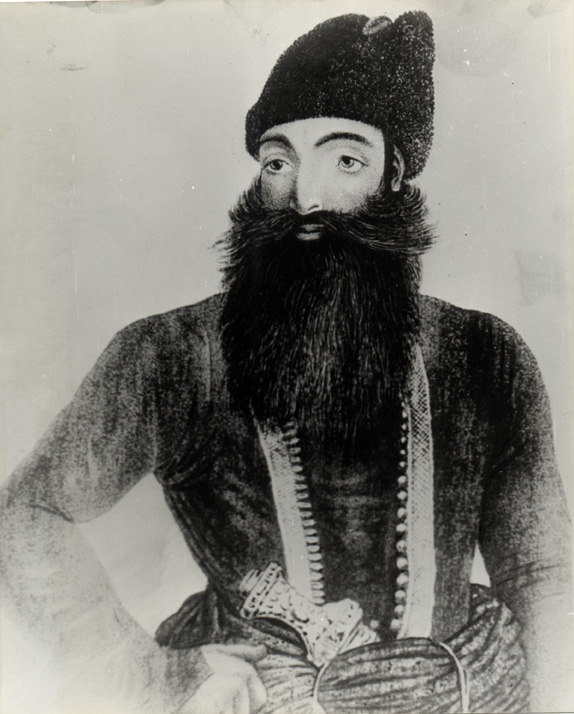 Crown Prince Abbas Mirza Nayeb-Saltaneh,
fourth son and crown prince of Fath 'Ali Shah Qajar; Father of Prince
Eskandar Mirza, ancestor of the Eskandaris.
Crown Prince Abbas Mirza Nayeb-Saltaneh,
fourth son and crown prince of Fath 'Ali Shah Qajar; Father of Prince
Eskandar Mirza, ancestor of the Eskandaris.
1. [NO PICTURE] Prince Eskandar Mirza, (b. 1226 in Tabriz--d.1273 in Tabriz/b. 1811--d.1857), 6th son of Crown Prince Abbas Mirza Nayeb-Saltaneh. Protector of Tabriz during the cholera epidemic of 1831. He was Governor of Khoy and Salmas under his brother's reign, Mohammad Shah Qajar, and at the beginning of the reign of his nephew Nasser ed-Din Shah Qajar, in 1264 (1848), was Governor of Qazvin until 1269 (1852). The Eskandaris derive their last name from Eskandar Mirza. Surnames were mandated during the reign of Reza Shah Pahlavi. Our family took the name of this ancestor. Before that, princes of the Qajar dynasty were simply known by their first names followed by the title "Mirza." Prince Eskandar Mirza had five children, the names of four whom we are missing in this genealogy for now. Of his children's descendants, we are only able to trace Prince Mohammad Taher Mirza's line so far. [To be completed]
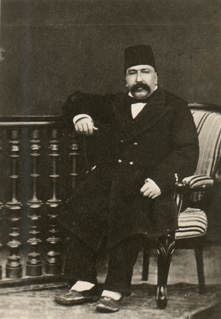 1.1 Prince Haji Mohammad Taher Mirza (Eskandari), (b. 1245 in Tabriz--d. 1317 in Tehran/b. 1829--d.1899), eldest son
of Prince Eskandar Mirza, cousin and French tutor of Nasser ed-Din Shah and Mozaffar ed-Din Shah, translator
of the works of Alexandre Dumas (the elder) into Persian such as The Count of Monte Cristo, The Three Musqueteers, and Queen Margot. Mohammad Taher Mirza
had three sons and two daughters:
1.1 Prince Haji Mohammad Taher Mirza (Eskandari), (b. 1245 in Tabriz--d. 1317 in Tehran/b. 1829--d.1899), eldest son
of Prince Eskandar Mirza, cousin and French tutor of Nasser ed-Din Shah and Mozaffar ed-Din Shah, translator
of the works of Alexandre Dumas (the elder) into Persian such as The Count of Monte Cristo, The Three Musqueteers, and Queen Margot. Mohammad Taher Mirza
had three sons and two daughters:
1.1.1 Prince Mohsen Mirza (Eskandari), Kafil ed-Dowleh, son of Prince Mohammad Taher Mirza, and father of 1.1.1.1 Yahya Mirza (see below), 1.1.1.2 Soleyman Mirza (see below), 1.1.1.3 Issa Mirza (see below); 1.1.1.4 Princess Shokouh Aghdass and 1.1.1.5 Princess Ghods Azam and 1.1.1.6 Princess Zahra ("Khanom Princess Azam") (see below). Princess Ghods Azam's son was 1.1.1.5.1 Manouchehr Mirza Eskandari (I). Mohsen Mirza Eskandari was Iradj Mirza's grandfather (see below).
1.1.2 Prince Mohammad Ali Mirza (Eskandari), "Prince Ali Khan," son of Prince Mohammad Taher Mirza, brother of Mohsen Mirza. Prince Ali Khan had three sons and four daughters. He was the father of 1.1.2.1 Azizollah Mirza (see below), 1.1.2.2 Abbas Mirza (see below), 1.1.2.3 Mohammad Taher Mirza (see below), 1.1.2.4 Princess Shahzadeh-Molouk, 1.1.2.5 Princess Mohtaram (see below), 1.1.2.6 Princess Showkat-el Molouk (see below), and 1.1.2.7 Princess Mehranguiz (see below). Grandfather of Manoutchehr Mirza (II) (see below). Prince Ali Khan was a liberal thinker, founding member of the secret Adamyat Society and teacher at the Dar-ol-Fonoun, Nasser-ed-din Shah's Polytechnic School in Tehran.
1.1.3 [NO PICTURE] Prince Mohammad Hassan Mirza (Eskandari), son of Prince Mohammad Taher Mirza from a second wife. He had three sons, 1.1.3.1 Jahangir Mirza, 1.1.3.2 Farhad Mirza and 1.1.3.3 Kamran Mirza, they each have issue [to be completed.]
1.1.4 [NO PICTURE] Princess Shahzadeh Khanom, daughter of Prince Mohammad Taher Mirza, m. Shahzadeh Ahmad Mirza Kavoussian. She had one son, 1.1.4.1 Prince Malek Ghassem Mirza Kavoussian, and two daughters:, 1.1.4.2 Princess Mansour Zaman (Mansour Zaman Khanom) and 1.1.4.3 Princess Homayoun Tadj (Homayoun Tadj Khanom). Prince Malek Ghassem Mirza married his cousin Tourandokht Khanom, daughter of Princess Shahzadeh Molouk from her second marriage (see below). They had no children. Princess Mansour Zaman married her cousin Abbas Mirza Eskandari (see below). Princess Homayoun Tadj married her second cousin Iradj Mirza Eskandari (see below).
1.1.5 [NO PICTURE] Princess Roghiyeh Hajieh Shahzadeh Khanom, daughter of Prince Mohammad Taher Mirza, m. Mohammad Khan Sardaari Iravani (son of Ahmad Khan Qajar Qovanlu "Moshir Hozour," son of Yousef Khan Qajar Qovanlu "Sartip"). They had children as follows: 1.1.5.1 Akhtar ol-Molouk, 1.1.5.2 Fakhr-e Alam, 1.1.5.3 Mahrokhsar, 1.1.5.4 Soltan Massoud, 1.1.5.5 Hesamedin. They each have children.
* * * * *
Children of Mohsen Mirza Kafil ed-Dowleh (1.1.1) :
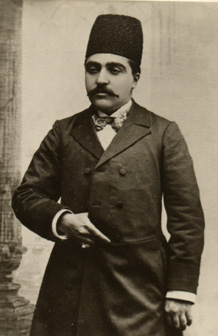 1.1.1.1 Prince Yahya Mirza (Eskandari), son of Prince Mohsen Mirza
(Eskandari), Kafil-ed-Dowleh. Father of Iradj Mirza (see below). Elder brother
of Soleyman Mirza (see below); husband of Princess Shahzadeh-Molouk (see below),
his paternal cousin. Member of "Adamyat Society," ardent leader
of the Constitutionalist movement. He died as a result of the wounds inflicted
on him in Mohammad Ali Shah Qajar's jail. He was both the inspiration for
Soleyman Mirza's activism and for that of his own son, Iradj Mirza.
1.1.1.1 Prince Yahya Mirza (Eskandari), son of Prince Mohsen Mirza
(Eskandari), Kafil-ed-Dowleh. Father of Iradj Mirza (see below). Elder brother
of Soleyman Mirza (see below); husband of Princess Shahzadeh-Molouk (see below),
his paternal cousin. Member of "Adamyat Society," ardent leader
of the Constitutionalist movement. He died as a result of the wounds inflicted
on him in Mohammad Ali Shah Qajar's jail. He was both the inspiration for
Soleyman Mirza's activism and for that of his own son, Iradj Mirza.
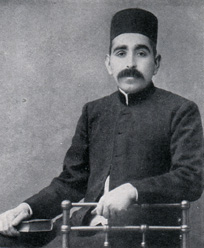 1.1.1.2 Prince Soleyman Mirza (Eskandari),
son of Prince Mohsen Mirza (Eskandari), Kafil-ed-Dowleh. Brother of Yahya
Mirza, uncle of Iradj Mirza (see below). Ardent constitutionalist; member
of the first through fifth Madjles; member of the social democratic party
of Persia; founder of the socialist party of Persia; founding member of the
Tudeh Party of Iran. He was one of the personalities consulted by Reza Khan,
later Reza Shah Pahlavi, when Reza Khan intended to form a government in the
anticipated absence of Soltan Ahmad Shah. Soleyman Mirza's trust in the democratic
pretensions of Reza Khan was later betrayed when Reza Khan declared himself
dictator and then Shah of a new dynasty. He was silenced by Reza Shah, and
remained in voluntary seclusion in his home for the duration of Reza Shah's
reign (a fact that saved his life!). In 1941, when Reza Shah was made to flee
the country by the British, the news was brought to Soleyman Mirza by his
nephew Abbas Mirza Eskandari. At that moment he left his house a free man
after almost fifteen years of seclusion. He died shortly thereafter in 1943.
1.1.1.2 Prince Soleyman Mirza (Eskandari),
son of Prince Mohsen Mirza (Eskandari), Kafil-ed-Dowleh. Brother of Yahya
Mirza, uncle of Iradj Mirza (see below). Ardent constitutionalist; member
of the first through fifth Madjles; member of the social democratic party
of Persia; founder of the socialist party of Persia; founding member of the
Tudeh Party of Iran. He was one of the personalities consulted by Reza Khan,
later Reza Shah Pahlavi, when Reza Khan intended to form a government in the
anticipated absence of Soltan Ahmad Shah. Soleyman Mirza's trust in the democratic
pretensions of Reza Khan was later betrayed when Reza Khan declared himself
dictator and then Shah of a new dynasty. He was silenced by Reza Shah, and
remained in voluntary seclusion in his home for the duration of Reza Shah's
reign (a fact that saved his life!). In 1941, when Reza Shah was made to flee
the country by the British, the news was brought to Soleyman Mirza by his
nephew Abbas Mirza Eskandari. At that moment he left his house a free man
after almost fifteen years of seclusion. He died shortly thereafter in 1943.
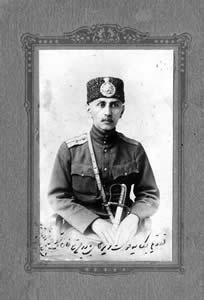 1.1.1.3 Prince
Issa Mirza (Eskandari), son of Prince Mohsen Mirza (Eskandari), Kafil-ed-Dowleh.
Brother of Yahya Mirza and Soleyman Mirza, uncle of Iradj Mirza (see below).
He had three children: 1.1.1.3.1 Amirzadeh Mirza Eskandari, 1.1.1.3.2 Fereydoun
Mirza Eskandari, 1.1.1.3.3 Jamshid Mirza Eskandari, 1.1.1.3.4 Siavosh Mirza, 1.1.1.3.5 Princess Mahine Eskandari and 1.1.1.3.6 Princess Badr-el-Molouk Eskandari. They each
have descendants. [To be completed]
1.1.1.3 Prince
Issa Mirza (Eskandari), son of Prince Mohsen Mirza (Eskandari), Kafil-ed-Dowleh.
Brother of Yahya Mirza and Soleyman Mirza, uncle of Iradj Mirza (see below).
He had three children: 1.1.1.3.1 Amirzadeh Mirza Eskandari, 1.1.1.3.2 Fereydoun
Mirza Eskandari, 1.1.1.3.3 Jamshid Mirza Eskandari, 1.1.1.3.4 Siavosh Mirza, 1.1.1.3.5 Princess Mahine Eskandari and 1.1.1.3.6 Princess Badr-el-Molouk Eskandari. They each
have descendants. [To be completed]
1.1.1.4 [NO PICTURE] Princess Shokouh Aghdass [To be completed]
1.1.1.5 [NO PICTURE] Princess Ghods Azam [To be completed]
1.1.1.6 [NO PICTURE] Princess Zahra ("Khanom Princess Azam"), daughter of Mohsen Mirza Kafil-ed-Dowleh, (m. Radpour). Mother of Mr. Houshang Radpour. He married his second cousin, Mahin Khanom, daughter of Princess Showkat-el-Molouk (daughter of Prince Ali Khan) and Prince Hossein Mirza Azodi (see below).
* * * * * *
Children of Mohammad Ali Mirza "Prince Ali Khan" (1.1.2):
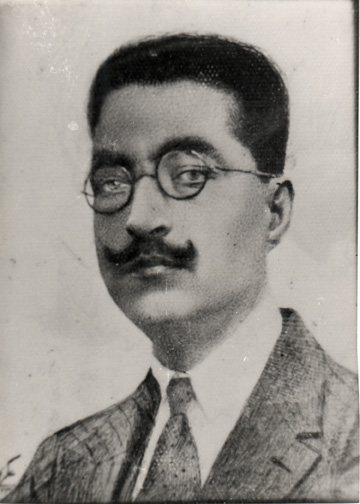 1.1.2.1 Prince
Azizollah Mirza (Eskandari), E'zaaz ed-Dowleh, son of Prince Ali Khan;
cousin and brother-in-law of Yahya Mirza and Soleyman Mirza Eskandari. Older
brother of Abbas Mirza (see below), Mohammad Taher Mirza and Princess Shahzadeh-Molouk
(wife of Yahya Mirza) (see above). Father of 1.1.2.1.1 Manoutchehr Mirza (II)
(see below), 1.1.2.1.2 Farrokh-Tadj Khanom, 1.1.2.1.3 Mahin-Tadj Khanom, 1.1.2.1.4
Ardeshir Mirza and 1.1.2.1.5 Dorrat ot-Tadj Khanom. Governor of Gorgan under
Soltan Ahmad Shah, he was condemned to house arrest by Reza Shah Pahlavi and
lost all his properties and wealth to him when, after the latter's ascension
to the throne, he wrote to Reza Shah declaring that as a Qajar prince
he does not recognize Reza Khan as the rightful ruler of the country and as
his king. He died at the age of forty, under suspicious circumstances, in
internal exile, in Tehran.
1.1.2.1 Prince
Azizollah Mirza (Eskandari), E'zaaz ed-Dowleh, son of Prince Ali Khan;
cousin and brother-in-law of Yahya Mirza and Soleyman Mirza Eskandari. Older
brother of Abbas Mirza (see below), Mohammad Taher Mirza and Princess Shahzadeh-Molouk
(wife of Yahya Mirza) (see above). Father of 1.1.2.1.1 Manoutchehr Mirza (II)
(see below), 1.1.2.1.2 Farrokh-Tadj Khanom, 1.1.2.1.3 Mahin-Tadj Khanom, 1.1.2.1.4
Ardeshir Mirza and 1.1.2.1.5 Dorrat ot-Tadj Khanom. Governor of Gorgan under
Soltan Ahmad Shah, he was condemned to house arrest by Reza Shah Pahlavi and
lost all his properties and wealth to him when, after the latter's ascension
to the throne, he wrote to Reza Shah declaring that as a Qajar prince
he does not recognize Reza Khan as the rightful ruler of the country and as
his king. He died at the age of forty, under suspicious circumstances, in
internal exile, in Tehran.
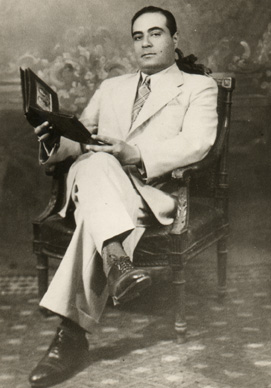 1.1.2.2 Prince
Abbas Mirza (Eskandari), son of Prince Ali Khan, cousin and brother-in-law
of Yahya Mirza and Soleyman Mirza. Brother of Azizollah Mirza, Mohammad Taher
Mirza and Princess Shahzadeh-Molouk (wife of Yahya Mirza); uncle and brother-in-law
of Iradj Mirza (see below); uncle and father-in-law of Manoutchehr Mirza (II) (see
below). Husband of Mansour Zaman Khanom, his paternal cousin (daughter of
Princess Shahzadeh Khanom, daughter of Prince Mohammad Taher Mirza, and Shahzadeh
Ahmad Mirza Kavoussian). Father of: 1.1.2.2.1 Nasser-ed-Din Mirza, 1.1.2.2.2
Sorayya Khanom and 1.1.2.2.3 Ghodse Iran Khanom (Ghodsi Khanom). Nasser-ed-Din
Mirza did not have issue. Sorayya Khanom married her paternal cousin, Manoutchehr
Mirza Eskandari (II). From that marriage there is no issue. Ghodsi Khanom married
and has one son. Abbas Mirza was a lawyer, politician, editor of several newspapers,
governor of Tehran, cabinet minister under Ghavam Saltaneh, member of the
14th and 15th Majles, famous orator and political opposition leader in the
Majles. He was responsible for the admission by Taghizadeh, in the Majles,
that the 1933 oil agreement with England was signed under duress. He is the
author of "Ketab-e Arezoo: Tarikh-e Mofassal-e Mashrutiyat," a bombshell
of revelations about the secret dealings under Reza Shah's regime. He spent
most of his best years in Reza Shah's jail, was active in politics from 1941 to 1953 and because of his political activities was forced to leave the country
after the August 1953 coup ("28th of Mordad") that brought Mohammad Reza Shah back to power. While in Europe, Abbas Mirza died
on a visit to Munich, under suspicious circumstances, at the age of sixty.
1.1.2.2 Prince
Abbas Mirza (Eskandari), son of Prince Ali Khan, cousin and brother-in-law
of Yahya Mirza and Soleyman Mirza. Brother of Azizollah Mirza, Mohammad Taher
Mirza and Princess Shahzadeh-Molouk (wife of Yahya Mirza); uncle and brother-in-law
of Iradj Mirza (see below); uncle and father-in-law of Manoutchehr Mirza (II) (see
below). Husband of Mansour Zaman Khanom, his paternal cousin (daughter of
Princess Shahzadeh Khanom, daughter of Prince Mohammad Taher Mirza, and Shahzadeh
Ahmad Mirza Kavoussian). Father of: 1.1.2.2.1 Nasser-ed-Din Mirza, 1.1.2.2.2
Sorayya Khanom and 1.1.2.2.3 Ghodse Iran Khanom (Ghodsi Khanom). Nasser-ed-Din
Mirza did not have issue. Sorayya Khanom married her paternal cousin, Manoutchehr
Mirza Eskandari (II). From that marriage there is no issue. Ghodsi Khanom married
and has one son. Abbas Mirza was a lawyer, politician, editor of several newspapers,
governor of Tehran, cabinet minister under Ghavam Saltaneh, member of the
14th and 15th Majles, famous orator and political opposition leader in the
Majles. He was responsible for the admission by Taghizadeh, in the Majles,
that the 1933 oil agreement with England was signed under duress. He is the
author of "Ketab-e Arezoo: Tarikh-e Mofassal-e Mashrutiyat," a bombshell
of revelations about the secret dealings under Reza Shah's regime. He spent
most of his best years in Reza Shah's jail, was active in politics from 1941 to 1953 and because of his political activities was forced to leave the country
after the August 1953 coup ("28th of Mordad") that brought Mohammad Reza Shah back to power. While in Europe, Abbas Mirza died
on a visit to Munich, under suspicious circumstances, at the age of sixty.
1.1.2.3 [NO PICTURE] Prince Mohammad Taher Mirza (Eskandari), son of Prince Ali Khan, brother of Azizollah Mirza and Abbas Mirza, father of 1.1.2.3.1 Princess Jhaleh and 1.1.2.3.2 Princess Mehrvash. They each have children and live in Iran today. To be completed.
1.1.2.4 [NO PICTURE] Princess Shahzadeh Molouk (Eskandari), daughter of Prince Ali Khan, sister of Azizollah Mirza, wife of her cousin Prince Yahya Mirza Eskandari, mother of Iradj Mirza Eskandari (see below 1.1.1.1.1/1.1.2.4.1). She married a second time after his death in 1909, and had one daughter from that marriage, Tourandokht Khanom (1.1.2.4.2). Tourandokht Khanom married Malek Ghassem Mirza Kavoussian, son of Princess "Shahzadeh Khanom" (daughter of Prince Mohammad Taher Mirza I) and Shahzadeh Ahmad Mirza Kavoussian. (see above). They had no issue.
1.1.2.5 [NO PICTURE] Princess Mohtaram (Eskandari), daughter of Prince Ali Khan; sister of Azizollah Mirza, Abbas Mirza, etc.; Wife of Mirza Ali Khan Mohaqqeqi. One of the earliest pioneers of women's rights in Persia; founder of Jam'iyat-e tarraqqi-e neswan, (Society for the Advancement of Women); member of Adamyat Society on the eve of the Constitutional Revolution (1906). She died in 1925 at the age of 30 and had no children. (See Encyclopaedia Iranica, "Eskandari, Mohtaram" by Princess Mehranguiz Dowlatshahi.)
1.1.2.6 [NO PICTURE] Princess Showkat-el-Molouk (Eskandari),( m. Prince Hossein Mirza Azodi), daughter of Prince Ali Khan; sister of Azizollah Mirza, etc...,. Mother of Princesses Mahin (1.1.2.6.1) and Pouran Azodi (1.1.2.6.2). Mahin Khanom married her second cousin Houshang Radpour, son of Princess Zahra Eskandari (Khanom Princess Azam, daughter of Mohsen Mirza Kafil-ed-Dowleh). Mahin Khanom and Houshang Radpour had three children: Darioush, Shahriar and Nina Radpour. Darioush Radpour has three children, Arash, Demetra and Shahriar. Shahriar Radpour has no children. Nina Radpour (m. Radpour) has a son, Khashayar Radpour. Pouran Khanom did not marry and has no issue.
1.1.2.7. Princess Mehranguiz (Eskandari), daughter of Prince Ali Khan, sister of Azizollah Mirza. She had no issue.
* * * * * *
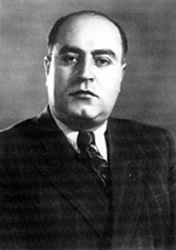 1.1.1.1.1 /1.1.2.4.1 Prince Iradj
Mirza (Eskandari), Iradj Eskandari, son of Prince Yahya Mirza and
Princess Shahzadeh Molouk, nephew and brother-in-law of Abbas Mirza Eskandari;
cousin of Manoutchehr Mirza Eskandari (II). Half-brother of Tourandokht Khanom, wife of Malek
Ghassem Mirza Kavoussian (see above). Husband of his paternal cousin Princess
Homayoun Tadj, daughter of Princess Shahzadeh Khanom (daughter of Mohammad
Taher Mirza Eskandari). Iradj Mirza was the father of (from a first marriage)
1.1.1.1.1.1 Iran Khanom (m. Sheybani), and from his marriage to Princess Homayoun
Tadj: 1.1.1.1.1.2 Yahya Mirza, 1.1.1.1.1.3 Hamila Khanom (m. Al-Sarraf) and
1.1.1.1.1.4 Shirin Khanom. Member of Ghavam Saltaneh's cabinet; member of
parliament; founding member, and later, secretary-general of the Tudeh Party
of Iran. In exile from 1946 to 1980, and again from 1981 to his death in 1985.
Considering his enormous influence over the politics of this half century
-- he was listed as one of the most feared politicians by the Pahlavi regime
--it is ironic how little time he actually spent in Iran.
1.1.1.1.1 /1.1.2.4.1 Prince Iradj
Mirza (Eskandari), Iradj Eskandari, son of Prince Yahya Mirza and
Princess Shahzadeh Molouk, nephew and brother-in-law of Abbas Mirza Eskandari;
cousin of Manoutchehr Mirza Eskandari (II). Half-brother of Tourandokht Khanom, wife of Malek
Ghassem Mirza Kavoussian (see above). Husband of his paternal cousin Princess
Homayoun Tadj, daughter of Princess Shahzadeh Khanom (daughter of Mohammad
Taher Mirza Eskandari). Iradj Mirza was the father of (from a first marriage)
1.1.1.1.1.1 Iran Khanom (m. Sheybani), and from his marriage to Princess Homayoun
Tadj: 1.1.1.1.1.2 Yahya Mirza, 1.1.1.1.1.3 Hamila Khanom (m. Al-Sarraf) and
1.1.1.1.1.4 Shirin Khanom. Member of Ghavam Saltaneh's cabinet; member of
parliament; founding member, and later, secretary-general of the Tudeh Party
of Iran. In exile from 1946 to 1980, and again from 1981 to his death in 1985.
Considering his enormous influence over the politics of this half century
-- he was listed as one of the most feared politicians by the Pahlavi regime
--it is ironic how little time he actually spent in Iran.
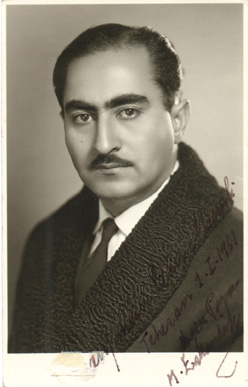 1.1.1.2.1
Prince Manoutchehr Mirza (II) (Eskandari), son of Prince Azizollah Mirza,
E'zaz-ed-Dowleh; nephew and son-in-law of Abbas Mirza Eskandari (see above); cousin of Iradj Mirza Eskandari (see above).
Father of 1.1.1.2.1.1 Manoutchehr M. Eskandari-Qajar (see below). Poet and
man of letters, first adjutant to General Batmanghilij; Cavalry officer and
retired major of the Iranian armed forces under Mohammad Reza Shah Pahlavi.
Because of his family name and close association with both Abbas Mirza and
Iradj Mirza, he was barred from holding any position in government or industry
under Mohammad Reza Shah Pahlavi. After returning from exile in the late fifties,
through the help of his cousin and namesake Manouchehr Farmanfarmaian, he
found employment at the N.I.O.C., where he remained until his death in 1983.
He never forgave the Pahlavis for the deaths of his father Azizollah Mirza
and his uncle, Abbas Mirza Eskandari. To him, not unlike Prince Mozaffar Firouz
and Iradj Mirza Eskandari, politics in Iran was
very personal. They had all suffered great losses and sacrificed greatly for
what they believed in deeply and dearly.
1.1.1.2.1
Prince Manoutchehr Mirza (II) (Eskandari), son of Prince Azizollah Mirza,
E'zaz-ed-Dowleh; nephew and son-in-law of Abbas Mirza Eskandari (see above); cousin of Iradj Mirza Eskandari (see above).
Father of 1.1.1.2.1.1 Manoutchehr M. Eskandari-Qajar (see below). Poet and
man of letters, first adjutant to General Batmanghilij; Cavalry officer and
retired major of the Iranian armed forces under Mohammad Reza Shah Pahlavi.
Because of his family name and close association with both Abbas Mirza and
Iradj Mirza, he was barred from holding any position in government or industry
under Mohammad Reza Shah Pahlavi. After returning from exile in the late fifties,
through the help of his cousin and namesake Manouchehr Farmanfarmaian, he
found employment at the N.I.O.C., where he remained until his death in 1983.
He never forgave the Pahlavis for the deaths of his father Azizollah Mirza
and his uncle, Abbas Mirza Eskandari. To him, not unlike Prince Mozaffar Firouz
and Iradj Mirza Eskandari, politics in Iran was
very personal. They had all suffered great losses and sacrificed greatly for
what they believed in deeply and dearly.
[NO PICTURE] 1.1.1.1.1.2 Yahya Eskandari, son of Prince Iradj Mirza Eskandari, second cousin of Manoutchehr M. Eskandari-Qajar (see below). He has children [To be completed]
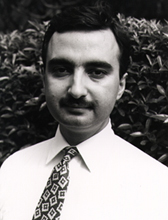 1.1.1.2.1.1
Manoutchehr M. Eskandari-Qajar, son of Prince Manoutchehr Mirza
Eskandari and his second wife, Gerlinde Maria. Father of 1.1.1.2.1.1.1 Amir-Hamsa
M. Eskandari-Qajar and 1.1.1.2.1.1.2 Yasamin Eskandari-Qajar
(see below). There have always been two strands in our family running side
by side, one politics, the other literary and academic pursuits. So far I
have chosen the academic route. However, in teaching politics, I have managed
to wed the two strands to my own satisfaction in my career as professor at
an American college.
1.1.1.2.1.1
Manoutchehr M. Eskandari-Qajar, son of Prince Manoutchehr Mirza
Eskandari and his second wife, Gerlinde Maria. Father of 1.1.1.2.1.1.1 Amir-Hamsa
M. Eskandari-Qajar and 1.1.1.2.1.1.2 Yasamin Eskandari-Qajar
(see below). There have always been two strands in our family running side
by side, one politics, the other literary and academic pursuits. So far I
have chosen the academic route. However, in teaching politics, I have managed
to wed the two strands to my own satisfaction in my career as professor at
an American college.
Amir-Hamsa M. Eskandari-Qajar and Yasamin (Yassi) Eskandari-Qajar children of Manoutchehr M. Eskandari-Qajar and Fariba Eskandari-Qajar (b. Nasri), for whose benefit this project was started and for whose edification this story was told. May they in turn tell it to their grandchildren's grandchildren!
Back to Qajar (Kadjar) Families Page